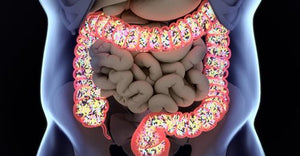Why Women Get More Fibromyalgia, IBS, and Anxiety Than Men

By Dr. David M. Brady and Danielle Moyer, MS
The occurrence of fibromyalgia is 10 to 20 times higher in women than in men [1]. Those women are also more likely than men to have severe tender points of pain, “pain all over”, sleep disturbances, and fatigue [2].
The incidence of Irritable Bowel Syndrome (IBS) is higher in women when compared to men. Internationally, the prevalence of IBS is 67% higher in women [3].
Anxiety disorders are more than twice as likely to occur in women when compared to men [4].
The question is: why?
Though the reasons are still being studied, research suggests that an interaction between biology, psychology, and sociocultural factors leads to higher occurrences of these diseases in women [5]. Of particular interest is the role of women’s hormonal and nervous systems, which respond somewhat differently to stress and trauma than those of men [1].
Research by the American Psychological Association looked at 290 studies between 1980 and 2005 to determine if men or women were more at risk for potentially traumatic events and PTSD (Post-traumatic Stress Disorder). The results concluded that, although men experience more traumatic events on average than women, women are more likely to meet diagnostic criteria for PTSD. PTSD is an anxiety disorder caused by a traumatic event and symptoms include “re-experiencing the trauma, avoidance and numbing and hyperarousal [6].” PTSD occurs in 10-12% of women and 5-6% of men, making the rate in women almost double [7]. Women’s PTSD also tends to last longer (on average four years), whereas men’s lasts one year on average [8].
The types of trauma men and women experience are different as well. Men are more likely to experience trauma from natural disasters, human-caused disasters, accidents, and combat, whereas women are more likely to experience trauma from domestic violence, sexual abuse, and sexual assault [6]. Sexual trauma has been shown to be particularly toxic to mental health, and can typically begin at a young age when the brain is still developing [8]. This can impact a woman's fear and stress response well into adulthood.
Trauma, stressors, and/or PTSD alter pain processing and incoming stimuli in an individual. They can frequently cause an excessive stress response, significant and chronic pain, and central sensitization disorders [1]. Central sensitization disorders cause a person’s nervous system to become regulated in a highly persistent state of reactivity, making their threshold to pain and touch incredibly low. This is associated with consistent and chronic pain [9]. Trauma, stressors, and/or PTSD can also affect the brain’s functioning by increasing hyperarousal, hypervigilance, and increased wakefulness and sleep disruption (learn more about sleep’s relationship to fibromyalgia here) [10].
Due to this, stressors or catastrophic events have been found to trigger the development of fibromyalgia, IBS, and anxiety. The intensity, multitude, or period of time of the “stressor” may even be a predictor of adverse health outcomes because they can lead to permanent changes in the human stress response systems [11].
In fact, studies show that “patients with fibromyalgia and related conditions may be more likely than nonaffected individuals to have experienced physical or sexual abuse in childhood. [11]” This intricate relationship can also cause an unfortunate domino effect. For example, increased hypervigilance from past traumas or stressors can cause a greater level of threat detection, which can then lead to increased anxiety, which can then increase hypervigilance yet again, and so on, creating a classic “feed-forward cycle”. Furthermore, increased hypervigilance has been shown to increase visceral pain perception in women with IBS and chronic pain states in women with fibromyalgia [12-14].
Female predominance in these syndromes and disorders can also be influenced by gender differences in… [15]
- Sociocultural reactions to pain/coping mechanisms
- Access to healthcare
- Research and resources on women’s health conditions
- Physiological reactions to pain sensitivity and pain amplification to sensory stimuli
- Hormonal and nervous systems stress and trauma responses, as described above
More research is needed to explore this important connection between women’s trauma and subsequent health issues. We know that women are strong, but their vulnerability to developing fibromyalgia, IBS, and anxiety is unfortunately strong too.
To learn more about PTSD, please visit the National Institute of Mental Health’s website.
References:
- Brady DM, Schneider, MJ. Pain and Fatigue: When It’s Fibromyalgia and When It’s Not. Townsend Letter. October 2012;351:44-50.
- Forbes D, Chalmers A. Fibromyalgia: revisiting the literature. J Can Chiropr Assoc. 2004;48(2):119-131.
- Canavan C, West J, Card T. The epidemiology of irritable bowel syndrome. Clin Epidemiol. 2014;6:71-80. doi:10.2147/CLEP.S40245
- Anxiety Disorders. Office on Women’s Health website. https://www.womenshealth.gov/mental-health/mental-health-conditions/anxiety-disorders. Published January 30, 2019. Accessed April 14, 2021.
- Yunus MB. The role of gender in fibromyalgia syndrome. Curr Rheumatol Rep. 2001;3(2):128-134. doi:10.1007/s11926-001-0008-3
- Tolin DF. Women Are Diagnosed with PTSD More than Men, Even Though They Encounter Fewer Traumatic Events, Says Research. American Psychological Assocation website. https://www.apa.org/news/press/releases/2006/11/ptsd-rates. Published 2006. Accessed April 14, 2021.
- Olff M. Sex and gender differences in post-traumatic stress disorder: an update. Eur J Psychotraumatol. 2017;8(sup4). doi:10.1080/20008198.2017.1351204
- Greenberg M. Psychology Today website. https://www.psychologytoday.com/us/blog/the-mindful-self-express/201809/why-women-have-higher-rates-ptsd-men. Published September 25, 2018. Accessed April 14, 2021.
- McAllister MJ. What is Central Sensitization? Institute for Chronic Pain website. https://www.instituteforchronicpain.org/understanding-chronic-pain/what-is-chronic-pain/central-sensitization. Published March 23, 20213. Reviewed May 29, 20217. Accessed April 20, 2021.
- Sherin JE, Nemeroff CB. Post-traumatic stress disorder: the neurobiological impact of psychological trauma. Dialogues Clin Neurosci. 2011;13(3):263-278.
- Harris RE, Clauw DJ. Newer treatments for fibromyalgia syndrome. Ther Clin Risk Manag. 2008;4(6):1331-1342.
- Kimble M, Boxwala M, Bean W, et al. The Impact of Hypervigilance: Evidence for a Forward Feedback Loop. J Anxiety Disord. 2014;28(2):241-245. doi:10.1016/j.janxdis.2013.12.006
- Meleine M, Matricon J. Gender-related differences in irritable bowel syndrome: Potential mechanisms of sex hormones. World J Gastroenterol. 2014;20(22):6725-6743. doi:10.3748/wjg.v20.i22.6725
- Behavioral and Neuronal Investigations of Hypervigilance in Patients with Fibromyalgia Syndrome. Accessed April 14, 2021. https://journals.plos.org/plosone/article?id=10.1371/journal.pone.0035068
- Kim SE, Chang L. Overlap between functional GI disorders and other functional syndromes: what are the underlying mechanisms? Neurogastroenterology & Motility. 2012;24(10):895-913. doi:https://doi.org/10.1111/j.1365-2982.2012.01993.x
- David Brady







Comments 0